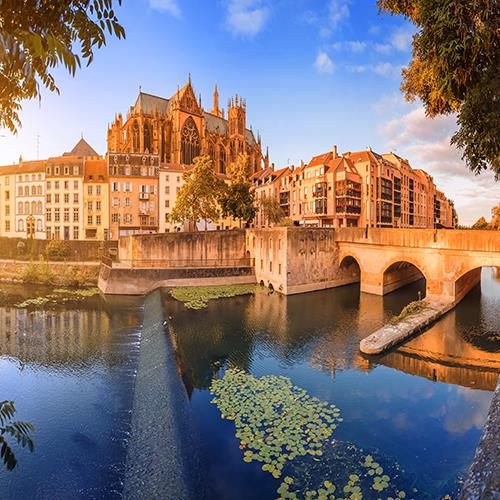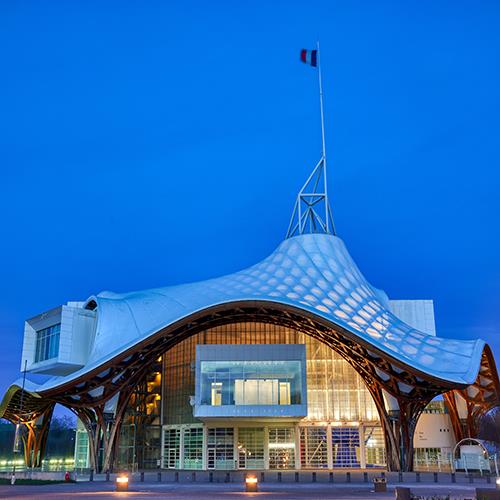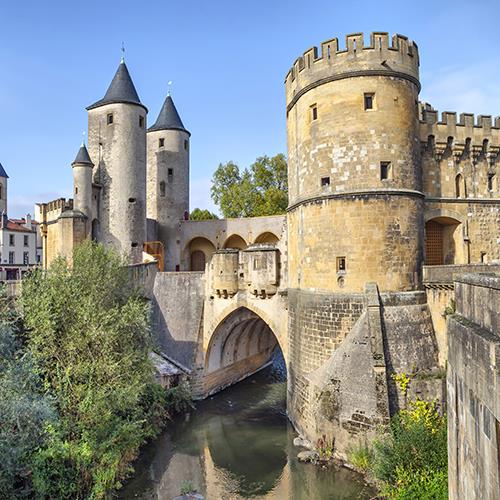EXPERIENCE METZ


Overview
A small piece of land where German Kings once ruled, Crusading Knights used to build their palaces, and where the French live today, Metz is alive with history and was often the site of many a historical event throughout its long and complicated history. Here’s a quick guide to the best things to do in Metz!
Metz is the administrative center of France’s new Grand Est region and has been a base of power for more than 2,000 years. It is a town where German Kings once ruled, Crusading Knights used to build their palaces, and where the French live today. Metz is alive with history and was often the site of many historic events that took place during its long and complicated history.
In this picturesque riverside city you’ll find impressive monuments and an atmospheric charm. Within Metz’s quaint historic center are winding cobblestone streets, beautiful old buildings, and a remarkable Gothic cathedral. Because of its extraordinary cultural heritage, Metz has earned the title of “Ville d’Art et d’Histoire” (City of Art and History).
The city is great for strolling the ancient streets, discovering historic churches, admiring masterpieces of art at renowned museums, shopping at fabulous boutiques and charming shops, wandering through the lush gardens where the old walls used to be, the atmospheric sidewalk cafes, and watching the world go by.






Things to See and Do
Centre Pompidou-Metz: Opened in 2010, this hip and trendy Centre Pompidou-Metz is located in the heart of the city, not far from the central train station. The award-winning modern art museum presents artwork created from 1905 to present and hosts various exhibitions year-round. The museum encourages viewers to interpret and appreciate modern and contemporary art.
Cathédrale Saint-Etienne: Located in the charming old town, and in the center of it all, there’s one of the tallest cathedrals in all of France to be found. The Roman Catholic eclesiastical building was constructed over more than 300 years from 1220 to 1552. It has more stained glass than any other cathedral in the world earning it the name, “La Lanterne du Bon Dieu” (the Lord’s Lantern). The windows have been created by gothic and renaissance master glassmakers, as well as the modern artists Marc Chagall and Jacques Villon.
La Cour d’Or Museum: In a group of buildings that includes the historic former Petities Carmes Abbey are three museums giving you the clearest picture of Metz’s glorious Gallo-Roman and Merovingian past, as well as its culture since then. Founded in 1839, the museum ensemble is named the palace in which the Austrasian Kings reigned and is an often bewildering maze of chambers and passageways, leading you to unforgettable artifacts, such as the 7th-century sculpted chancel from Saint Pierre-aux-Nannains, or historic architecture in situ, like the Roman baths in the basement.
Porte des Allemands: Named for the Teutonic Knights who founded a nearby hospital, and constructed during the middle ages (the same order who constructed both Bran Castle in Romania, and Malbork Castle in Poland), the Porte des Allemands is one of those places that’s even more breathtaking in person. Perched above the River Moselle, it’s a magnificent example of well-preserved fortifications dating back to the middle ages. It is essentially a gate with two sets of towers: Angular, crenellated ones facing towards the east of the Saar in the distance, and circular ones on the city side.
Église Saint-Maximin: The church of Saint-Maximin in the old town of Metz was built between the 12th and 18th century and well worth a look inside. The style of the ecclesiastical building is Romanesque and the stained glass windows were designed by the artist, writer and filmmaker Jean Cocteau in the early-1960s and installed posthumously.
Place Saint-Louis: The west side of this medieval square in the old center is one long terrace of renaissance houses over a stunning arcade. The arches are more reminiscent of somewhere in Tuscany than eastern France, and show how well the city was doing for itself in the middle ages. In the winter, the medieval square is the site of an authentic French Christmas market.
Imperial Quarter & Avenue Foch: When Kaiser Wilhelm II had control over Metz in the early 20th-century, he envisioned creating a whole new imperial city, at the edge of his empire. This grand vision came partially to fruition in the form of the Imperial Quarter of Metz, specifically along Avenue Foch. And one of the best highlights of this part of the city is the Gare de Metz-Ville. The train was opened in 1908 and still contains the imperial apartments of Kaiser Wilhelm II.
Esplanade: These fabulous gardens also follow the course of Metz’s old defences, on the site of a vast ditch filled in after the citadel was pulled down in 1816. In these French gardens with geometric lawns and hedges trimmed to right angles you can look out to Mont Saint-Quentin, climbing to the west of the city. This location is where the life of Metz’s city celebrations take place with fairs, carnivals, skating rinks, and more!
Le Temple Neuf: In the heart of Metz, another landmark created in the decade of German control is this Romanesque revival church on the Petit-Saulcy river island, just down from the Place de la comdie. The church is where Metz’s protestant congregation comes to worship and is constructed with a dark gray sandstone, giving it a completely different feel to the city’s older monuments, made with yellowy Jaumont limestone. Just behind the church, you’ll find the ‘garden of love’ which is the perfect spot to relax in the summer months, gaze across the Moselle, and watch the world go by.
Eglise Saint-Pierre-aux-Nonnains: The oldest church in France can be found in Metz and dates back to the 4th century on the site of the ancient Gallo-Roman city. Originally a Roman basilica, the building was later used for the Benedictine abbey, which was founded in the 7th century. In the 16th century, the church was incorporated into the town’s defenses.
Today, the church is used as a cultural center and exhibition hall and offers an incomparable setting for music concerts and temporary exhibitions. Visitors will also enjoy exploring the area around the church, the Quartier Citadelle neighborhood, which has many stately old buildings and lovely green spaces.
Promenade along the Moselle River: The Moselle River promenade and park is worth a stroll. In the spring, the trees are blossoming and the gardens are filled with colorful flowers, it is beautiful! It is the perfect place to relax and unwind on a bench under the tree lined promenade. As you stroll, you’ll come across a little park full of beautiful swans. It is one of the most beautiful areas in the city, and there is also a playground here for kids!

Covered Market
The horseshoe-shaped market sells all manner of fresh produce from throughout the Lorraine area and beyond. The historic marketplace is one of the oldest (and certainly one of the grandest) in all of France.
First built as a bishop’s palace in the 18th-century, the French Revolution actually broke out before the Bishop of the time was able to move in. Following the French Revolution, citizens of Metz decided to transform the palace into a food market instead!
The Marché Couvert has served as a market ever since, and today it comprises over 40 stalls.

Local Cuisine
Metz traditional cuisine is quite simple and satisfying. They prepare many meat dishes here, among which Potée Lorraine stands out. This is what they call a pork and vegetable stew, which has dozens of recipes. In addition to pork, various smoked sausages and lard can be added to it, and the most common vegetable components are cabbage, potatoes, turnips, onions, and carrots. If you’re looking for more original dishes, try “Salade de pissenlit” - a dandelion salad. At local restaurants, the dish is especially common in summer. Its components are very simple - dandelions, pork fat, and butter. Among the common desserts is “Wagotines” - wonderful praline pastries traditionally made exclusively by hand.
Of course, quiche lorraine is a staple of the city, a pastry pie made with eggs, crème fraîche and bacon. The earliest mention of this dish dates to the beginning of the 17th century and it was originally also made with emmentaler cheese, which still appears in some varieties.
The damson and mirabelle plums grown in the countryside appear not just in tarts, brandies and jams, but also some of the charcuterie made in the Lorraine region.

Festivals and Nightlife
As is the case in many larger French towns and cities, annual festivities are held in Metz during much of the year. From the balloon festival held just outside the city on an annual basis to the”Le Livre à Metz”, Literature and Journalism Festival which is perfect for bibliophiles, there’s no shortage of things to see and do in the city throughout the year! Note: Most interesting holidays and festivals take place in summer and September. During this period, guests of the city can enjoy the most diverse entertainment.
The city has many nightclubs and bars, creating excellent conditions for an exciting evening. One of the most popular places in town is Le Troubadour, which has become a permanent venue for fiery parties and music concerts. Famous rock musicians and jazz bands often perform at this club. Themed programs are organized for visitors several times a week. A huge selection of signature cocktails and treats will be a nice complement to evening relaxation.